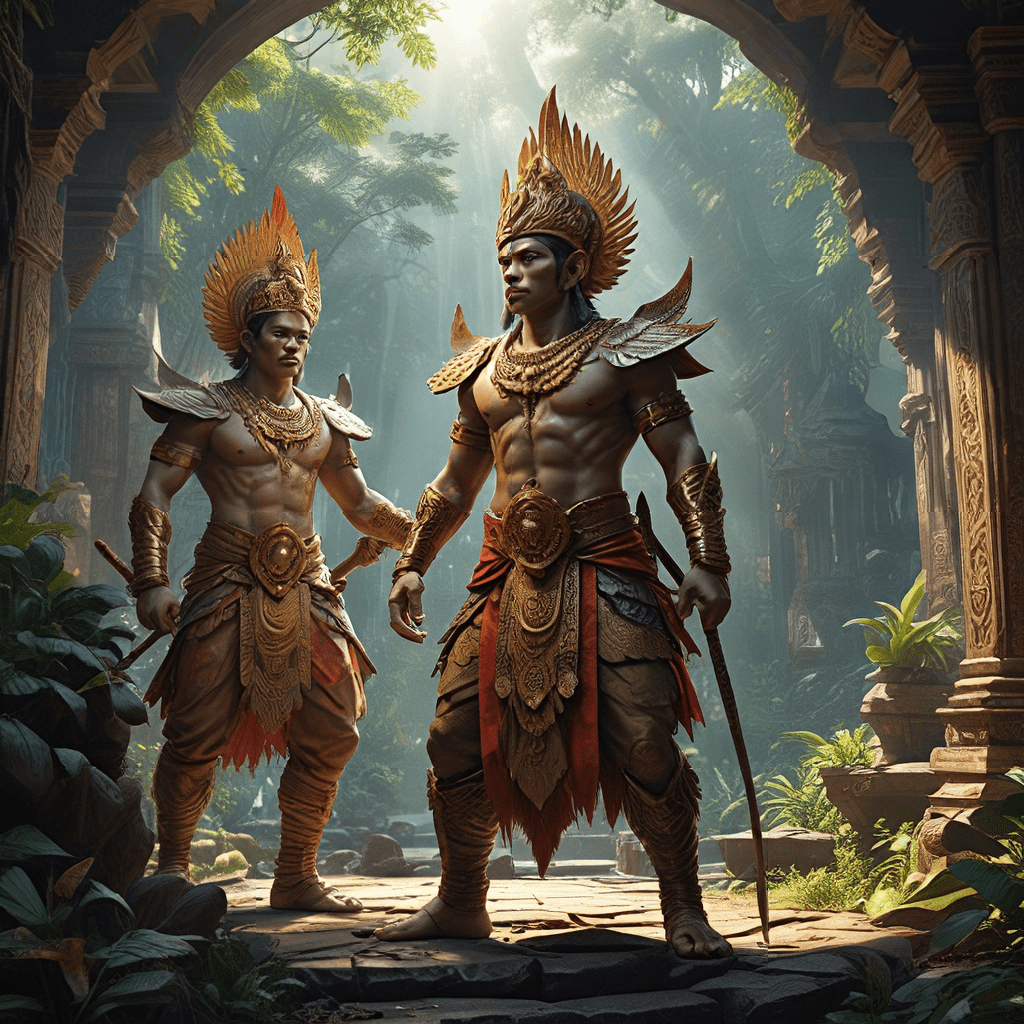Indonesian Mythology: A Tapestry of Dualistic Concepts
Indonesian mythology is a rich and vibrant tapestry woven from countless stories, legends, and beliefs that have been handed down through generations. At the heart of this tapestry lies a profound concept: dualism. This idea of opposing forces existing in harmony, or sometimes conflict, is a fundamental principle that shapes many aspects of Indonesian mythology. From the creation of the universe to the nature of the human soul, the concept of dualism permeates the very fabric of Indonesian beliefs.
The Cosmic Dance of Duality: A Foundation of Indonesian Mythology
In Indonesian mythology, the universe is often understood as a product of duality. This dualistic principle can be seen in the creation myth of the Batak people, where the universe is born from the union of two primordial beings, a male god named Batara Guru and a female goddess named Ompung. These two divine beings represent the fundamental principles of male and female, light and dark, order and chaos. Their union gave birth to the world, demonstrating the inherent interconnectedness of opposing forces.
This concept of duality is also evident in the belief in the "pusat" or center of the universe. This concept highlights the importance of balance and harmony, as the center is believed to be the point where all forces converge and find equilibrium. This understanding of the universe as a place where opposing forces are in constant interplay is a central theme in Indonesian mythology.
Ruh and Nyawa: The Yin and Yang of the Indonesian Soul
In Indonesian mythology, the human soul is believed to be composed of two distinct parts: the "ruh" and the "nyawa." The "ruh" represents the spiritual essence of the individual, while the "nyawa" embodies the physical and emotional aspects of life. These two elements are often seen as complementary forces, working together to create a complete and harmonious human being.
The "ruh" is often associated with the soul's connection to the divine, while the "nyawa" is linked to the earthly realm. The "ruh" is believed to be immortal, whereas the "nyawa" is temporary and tied to the physical body. This duality reflects the inherent tension between the spiritual and physical aspects of human existence, a theme that resonates with many cultures around the world.
The Eternal Conflict: Gods and Demons in Indonesian Mythology
Indonesian mythology is populated by a diverse cast of gods, goddesses, and mythical creatures. These beings often embody opposing forces, reflecting the inherent tension between good and evil, order and chaos, that is a cornerstone of Indonesian mythology.
One of the most prominent examples of this dualistic conflict is the story of the gods and the demons. The gods, led by Batara Guru, represent order, justice, and righteousness, while the demons, led by Kala, personify chaos, destruction, and evil. Their eternal struggle is a recurring theme in Indonesian mythology, symbolizing the constant battle between light and darkness, virtue and vice.
This conflict is not simply a battle between abstract forces; it is often reflected in the struggle between the individual and their inner demons. In many stories, heroes are tested by temptations and trials, symbolizing the ongoing battle within each human being against their own darkest impulses.
The Dual Nature of Creation: From Chaos to Order
The concept of dualism is also reflected in the Indonesian creation myths. In many of these stories, the universe is born from a state of primordial chaos. One of the most famous examples is the creation myth of the Bugis people, where the universe is created from the union of two primordial beings, a male god named La Galigo and a female goddess named We Tenri Abeng. Their union represents the merging of chaos and order, resulting in the creation of the world.
This dualistic creation story emphasizes the importance of balance and harmony in the universe. The creation of the world is not simply a process of bringing forth order from chaos, but rather a process of integrating both forces.
These creation myths suggest that the dualistic nature of the universe is inherent in its very origin. From the very beginning, the universe is understood as a place where opposing forces are constantly interacting, shaping and influencing the world.
The Interplay of Good and Evil: Embodied in Mythical Creatures
Indonesian mythology is teeming with fascinating creatures that embody the dualistic nature of good and evil. These mythical beings are often seen as representations of the forces that shape the human experience, both within and outside the individual.
One prominent example is the "garuda," a mythical bird-like creature that is often depicted as a powerful and benevolent protector. The "garuda" is a symbol of strength, courage, and righteousness, representing the triumph of good over evil. On the other hand, creatures like the "wewe gombel," a mischievous spirit that often kidnaps children, embody the darker forces of temptation and danger.
These mythical creatures are not simply whimsical creations; they often serve as cautionary tales and moral exemplars. They help people understand the complexities of human nature, the constant battle between good and evil, and the need to choose the path of righteousness. The presence of these creatures in Indonesian mythology speaks to the importance of recognizing and understanding the dualistic forces that are present in all aspects of life.
Theories of Dualism in Indonesian Mythology: Indigenous Roots vs. External Influences
While dualism is a prominent theme in Indonesian mythology, the origins of this concept are subject to ongoing academic debate. Some scholars argue that dualistic concepts are deeply rooted in indigenous Indonesian beliefs, while others believe that these concepts were introduced through external influences, primarily from Hinduism and Buddhism.
The belief in the interconnectedness of opposing forces is arguably a fundamental element of many indigenous cultures, suggesting that the concept of dualism may have existed in Indonesia before the arrival of other belief systems. However, there is evidence to suggest that Hinduism and Buddhism played a significant role in shaping and refining dualistic concepts within Indonesian mythology.
The Influence of Hinduism and Buddhism on Indonesian Dualistic Concepts
The arrival of Hinduism and Buddhism in Indonesia had a profound impact on the cultural and religious landscape of the archipelago. These belief systems introduced new ideas and concepts that enriched and expanded existing Indonesian beliefs, including the concept of dualism.
Hinduism, in particular, introduced the concept of Dharma and Adharma, representing righteousness and unrighteousness respectively. These concepts contributed to the development of the concept of good and evil in Indonesian mythology, shaping the narratives of gods and demons, and influencing the moral values of the people.
Buddhism introduced the concept of karma, which emphasizes the interconnectedness of actions and consequences. This concept further reinforced the idea of dualism by suggesting that actions have both positive and negative outcomes, influencing the individual's fate in this life and beyond.
The influence of Hinduism and Buddhism on Indonesian dualism is evident in the adoption of many Hindu and Buddhist deities into the pantheon of Indonesian gods. These deities often represent opposing forces, embodying the tension between good and evil, order and chaos, which were already present in indigenous beliefs.
The Role of Ancestor Worship in Shaping Dualistic Beliefs
Ancestor worship is a significant aspect of many Indonesian cultures, playing a crucial role in shaping their beliefs about life, death, and the afterlife. This practice reinforces the concept of dualism by emphasizing the connection between the physical and spiritual realms.
In ancestor worship, the deceased are believed to possess a spiritual essence that continues to exist after death. This essence can influence the lives of the living, sometimes in positive ways through blessings and protection, and sometimes in negative ways through curses and punishments.
The concept of ancestral spirits also highlights the dual nature of existence, reminding people of their connection to both the physical world and the spiritual world. It underscores the importance of maintaining a balance between these two realms, ensuring the well-being of both the living and the deceased.
Exploring the Contemporary Relevance of Indonesian Dualism
While Indonesian mythology may seem like a relic of the past, the concept of dualism remains surprisingly relevant in contemporary Indonesian society. The challenges of modern life often involve finding balance and harmony in a world filled with opposing forces.
The concept of dualism can help individuals navigate these challenges by providing a framework for understanding the complexities of human existence. It reminds us that everything has two sides, that every choice has consequences, and that finding a harmonious balance between opposing forces is crucial for well-being.
The ongoing relevance of dualism in Indonesian mythology highlights the timeless nature of these beliefs and their enduring ability to offer wisdom and guidance to people across generations.
FAQ
1. What are some examples of dualistic concepts in Indonesian mythology?
Some examples include the opposing forces of good and evil embodied in gods and demons, the concepts of "ruh" and "nyawa" representing the spiritual and physical aspects of the soul, and the creation of the universe from primordial chaos.
2. How did Hinduism and Buddhism influence Indonesian dualistic concepts?
These belief systems introduced new concepts like Dharma and Adharma, karma, and deities embodying opposing forces, enriching and expanding existing Indonesian dualistic beliefs.
3. What is the significance of ancestor worship in shaping dualistic beliefs in Indonesia?
Ancestor worship reinforces the concept of dualism by emphasizing the connection between the physical and spiritual realms, reminding people of their connection to both the living and the deceased.
4. How is the concept of dualism relevant in contemporary Indonesian society?
Dualism provides a framework for navigating the challenges of modern life, emphasizing the need for balance and harmony in a world filled with opposing forces.



